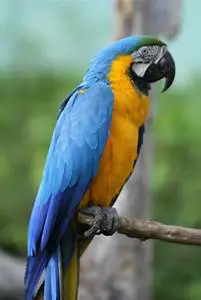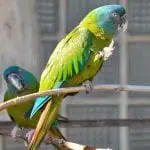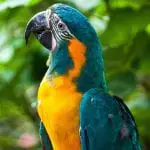Scientific Facts
| Common Name | Blue-and-gold Macaw, Yellow-breasted Macaw, Blue Macaw |
| Scientific Name | Ara ararauna |
| Size | 86 cm (33.5 in) |
| Life Span | 60 yrs |
| Habitat | wooded areas, usually near water, including the edge of lowland humid forest, gallery forest in savanna, savanna with scattered trees and palms, swamp forest, and palm swamp. |
| Country of Origin | South America |
There is no macaw with a more reputed appearance than the Blue and Gold Macaw. As their breathtaking and fascinating expressions set their fame as exceptionally elegant birds, these pet birds are a brilliant addition to advertisements, cartoons, and movies. Presenting them promptly accessible to obtain, they are likewise one of the most prevalent pet macaws.
Blue and Yellow Macaw is a species of parrot that has cleverly flushed blue and yellow plumage. They are additionally popular as a blue and gold macaw. Considering the wings are so appealing and engaging, these birds are famously identified as Ara ararauna, which is also their scientific name.
Physical Description
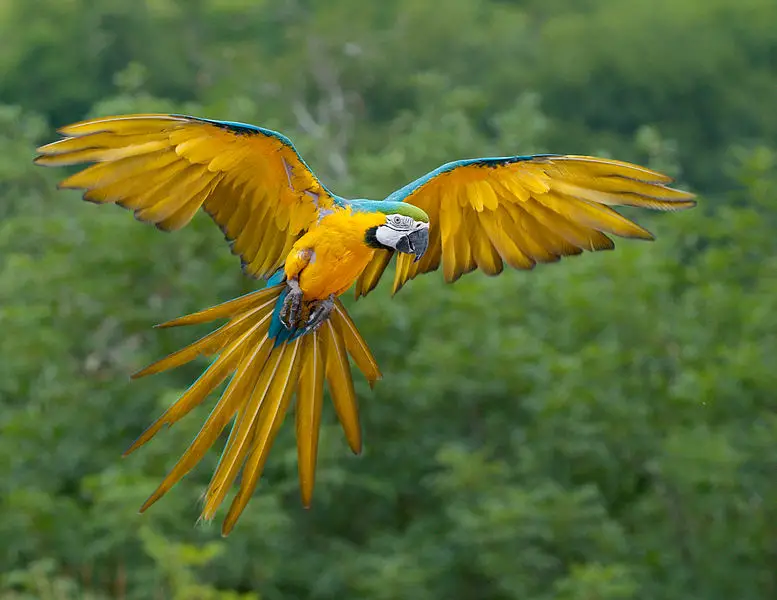
Blue and yellow macaws receive their popular name from their two most notable plumage shades. They commonly possess a green temple, decreasing into a sapphire azure that embraces the wings, tail, back, and nape. The underside of the wings, chest, and belly are a vibrant golden yellow.
These birds have huge black bills and a black spot of plumage merely below it. White specks of skin embellished with collars of little black plumage encircle their eyes and comprise much of the face.
The females and males are hardly perceptible since this is a monomorphic variety. It’s assumed that the male has a smoother head, and the female has a thinner bill, though the only means to determine the sex of this macaw is via DNA sexing or surgical.
The Blue and Yellow Macaw sizes approximately 86 – 91 cms in length from the top of its head to the peak of its tail, giving them one of the greatest macaws in the system. It has a wingspread of 104 to 114 cms and balances between 0.9 and 1.3 kgs.
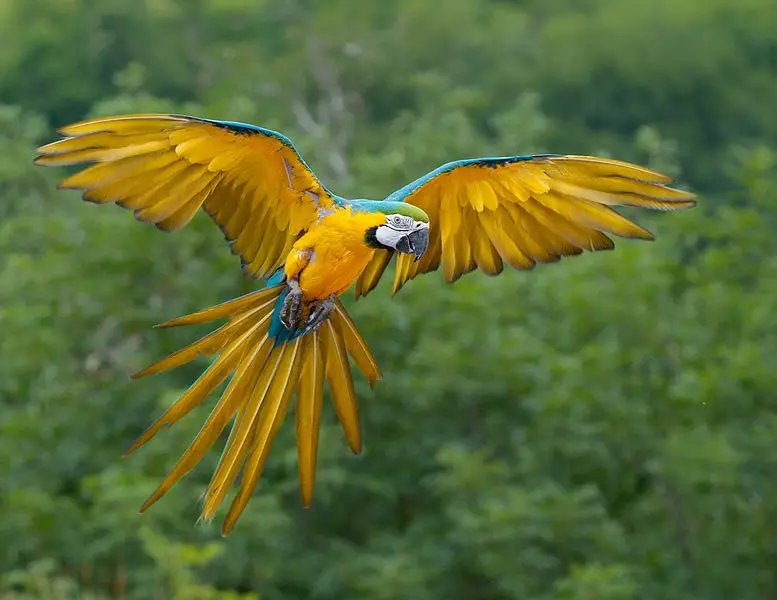
Species Specifics
- Bolivian Blue and Gold Macaw Not a presently identified subspecies, but merged with the proposed custom as the same species. May permit analysis and potential improvement in the future.
The Bolivian species are characterized by their enormous size. They are assumed to be greater than the standard Blue and Yellow Macaws. In reality, they are defined as transcending the standard-sized Green-wing Macaws and rarely even several Hyacinths. Feathers portrayed as more “pure blue” correlated to the ” green-blue” or sea-green pigmentation of the regular Blue and Gold.
- Blue-throated Macaw (Ara glaucogularis, formerly Araninde – suggested: Ara ararauna glaucogularis) – An Australian ornithologist and one of the world’s leading specialists on parrots, Joseph Michael Forshaw, affirmed that this macaw (discovered in the southern part of the Blue and Gold’s field) might signify a subspecies accordant with their comparable features. Some physical distinctions incorporate a somewhat smaller measurement, a less broad exposed facial area, more extensive black taggings on the chops, and a blue gorge spot that stretches up to the ear feathers coverts (coverts).
Geographical Range
They are observed in the swamps and subtropical and tropical woodlands of South America, including the countries Venezuela and Pana in the north, throughout Guyana, Suriname, and French Guiana to the east, Peru, Ecuador and Columbia in the west, and Brazil and the northern half of Bolivia in the southern part of the range. Extinct in Trinidad.
The population in Panama is secluded from the rest of the scale and is observed in the southern part of Panama, reaching into northern Columbia and a small part across the Venezuela/Columbia frontier in Venezuela.
Habitat
Their slumps have been associated with capturing for the pet trade, habitat destruction, and overhunting.
They populate valleys up to 500 meters (1,650 feet), building their shelters in swamps, marshlands, open savannas, riverside forests, and rainforests.
During the day, they are generally witnessed in couples, or small family crowds upheave in huge trees. Though, in the daylights and late evenings, they assemble noisy, large flocks as they circumnavigate to and from their feeding territories. When frightened, they normally travel within the atmosphere, shrieking shrilly.
Common Behavior
Sociable and intelligent, the blue and yellow macaw commonly makes great as a pet, when the masters are well-informed, dedicated, and responsible. They are huge macaws, and as such, are competent of remarkably intense vocalizations. Due to this, they may not be the most desirable option for those who reside in condominiums and apartments, or who have little kids.
Blue and golds do very well, adjusting to different situations when permitted to mingle with a variety of people. They’re a famous lead character at bird exhibits, and numerous masters bring them out and around the city with the aid of bird straps and car seats. Blue and yellow can be mere as approachable to different birds as they are to people.
Around the residence, these macaws can be as affectionate as a canine. They appreciate being adjacent to their partners and will frequently roam around seeking for someone who can provide them care. Their gentle nature is certain to get you to abandon whatever you’re making for short leisure. They can likewise be considerably satisfied on their roost, observing the movement encompassing them.
Speech & Sound
The blue-and-gold macaw is proficient in producing boisterous, similar to most macaws, head-splitting tones and can be inclined to rounds of shrieking. You will not be adequate to conceal this pet from a landowner, so learn the oral skills of this bird before you carry it home. There is no method to get a shrieking macaw to halt its vocalizations, particularly around nightfall, when macaws are most spoken. Blue-and-yellow macaws are intelligent speakers, proficient at reciting simple phrases and words.
Diet and Feeding Habits
When you speak concerning their nutrition, the macaws are fond of caffeine, avocados, cherries, chocolates, flowers, leaves, nuts, fruits, seeds, and the like.
Video Url
They make use of their black bills to consuming the already uncovered dried fruits and nuts. Besides the pet macaws, the birds remaining in the native are the principal reservoir of scattering grains of various fruits and are deemed a significant animal in developing several fruit trees in the jungle.
Reproduction and Life Cycle
The Blue and Yellow Macaw attain reproducing age when they are 3 to 4 years old. They are recognized to partner for life and reside in a small family flock. The exemplars that are reckoned to breed, commonly, remain extremely intimate with each other while hovering in a group or a flight. Blue and Yellow Macaws retreat raised over the territory in hollows located in great, stagnant woods. Solely two or three embryos are placed in a cradle. It is believed that the hen nurtures them. Though, both females and males strenuously protect the eggs.
The juveniles are visionless and apteric when they hatch. It gets nearly more than twenty days for the embryos to get born. The newborn macaws are quite feeble when they are produced. It is the progenitors that determine which newborns are healthier than the others, and they nourish solely the healthier individuals.
The juvenile Macaws do not manifest their entire feathers until they are at least 10 weeks old. After they develop plumage or mature, they stay with their parents for a few months before growing separate. They are deemed mature enough to breathe on their own and are entitled to raise their own kind when the junior macaws are four years old. Blue and yellow Macaw can exist relevant to 60 years of age.
The Oldest RECORDED Macaw is …
In 1899, Charlie, a female Blue and Gold Macaw, reported to have hatched, and she celebrated her 112th birthday in 2011 accordingly. She is assumed to have once regarded to Winston Churchill. This Blue and Yellow Macaw has attained recognition for her anti-Nazi scolding. She lives at Heathfield Nurseries, Reigate, Surrey, in Great Britain.
However, the Guinness World Records recognized Poncho, a green-winged macaw, as the oldest living parrot in the world. Cookie parted when she was 92 years old. She is kept by Birds and Animals Unlimited, a company that gives Warner Brothers and Universal film studios with creatures and animals required for their films.
The uttermost period can most efficiently be obtained by confined birds that are well attended for. In the wild, chicks, eggs, and some grown-ups become victim to birds of prey, such as reptiles (snakes, for example), Orange-crested Falcons, Hawk Eagles, and Harpy Eagles, and humans, who kill them for their meat and feathers.
How to Breed
Blue and Yellow Macaws attain generative period when they are nearly 3 to 4 years old. Once they have gained an appropriate partner, they are commonly paired for life (monogamous). However, they may substitute a partner that they have missing.
Most breeding ventures transpire between January through July (in the United States between March and September). They commonly reproduce every 1 to 2 years.
In their wild territory, they dwell in the empty logs of lifeless trees or holes (natural or dug by other birds) in towering trees high up to dodge predation. In restrained breeding conditions, 135-litres (35-gallons) solution containers or level cradle crates – measured approximately 41 cm x 41 cm x 122 cm (16″ x 16″ x 48″) – have been favorably used.
The offsprings balance about 14 – 20 g (0.5 – 0.7 oz) and are visionless, apteric, and entirely reliant on parental supervision. For the initial week, the female solely supports the juvenile during regurgitation, and after that moment, the male will normally help. Approximately 10 days later, the juvenile grows plumage. Both origins are extremely defensive of their junior and strenuously protect them toward invaders. The juvenile leaves (fledge) the cradle when they are roughly 90 to 100 days old. By the course they begin filling on their wean (own), they measure about 1,000 g (5 oz).
In Captivity
In confinement, hybridism is comparatively normal. First-generation hybrids include Miligold Macaws, Maui Sunset Macaws, Caloshua Macaws, Bluffon’s Macaws, Harlequin Macaws, and Catalina Macaws. Second-generation hybrids are Harligold Macaws and Catablu Macaws.
Breeding couples demand passage to huge flights that are at least 15 meters (50 feet) long.
Pet Care
Albeit admired as pets due to their stunning features and expertise to speak, they need much more training and more information – from masters than more common pets such as canines or felines. They are bright and friendly, so for someone who can accommodate their requirements, they do great comrade animals.
Baby
Yet the best attended for, well-adapted blue and yellow macaw will “shriek” and perform other boisterous sounds. Ear-piercing vocalizations and catastrophic grinding are common components of their practice and must be assumed in confinement. Commonly, they will make harsh piercing cries if they are frightened or agitated. In the evening, they likewise generally articulate for 10 minutes as the sun is setting.
Housing
They will need a spacious enclosure, at least 36’’x24’’x60’’. Equip firm roosts, playthings, both for performing and grinding. You can devote a place in your apartment for your macaw, or you can place it in an outside aviary. Allow it to consume some event, optionally at least 2-3 hours outside the enclosure.
The enclosure and roost must be large enough to adequately dwell such a great bird, with loads of opportunity to spread his wings, leap and soar around, and have himself engaged. Some masters even produce a dedicated bird place.
Ideally, they must have a sound-size entertainment space.
Temperature
A blue and yellow macaw is commonly satisfied with conditions varying between 21°C-27°C (70°F-80°F).
Exercise
In the native, they will consume an ample chance of their days on woods personalizing their habitat, caring for their chicks, preening and interacting with their mates, foraging for food, and building nests. At your residence, one of their main ventures will be grinding, examining objects (Some matter) with their bills. Blue and Yellow Macaws, similar to all macaws, will nibble on your jewelry, electric wing, furniture – any object they can take grasp of. This is a normal response.
To some degree, you can deflect grinding to playthings, but a macaw abandoned solely, unconfined in a studio, will apt refurbish. By presenting various pastimes in the enclosure, one can lessen the adverse nibbling as the bird will concentrate munching on those suitable gadgets.
They need a setting that enables them to grind as abundant as they require, playthings to have them occupied, a space that is effortlessly washed and sustained. Not a bird for most families, but an origin of vast entertainment, incredible fellowship (and, certainly, the particular sorrow over damaged movables) – for the accurate master. If their demands are not sufficed, they are inclined to exhibit behavioral dilemmas, such as excessive feather plucking, biting, or screaming. In difficult situations, they may start to hurt themselves.
Bird coating of ranges they travel around it is highly relevant, for their protection as strongly as yours (broken electrical cables can end in flames). Bird keepers regularly obtain ideas to store cords or preserve them with flexible tubing accessible at Home Depot (or similar shop).
Care
Macaws originate from a sultry environment, and regular showering breaks must be provided to them. Without some moisture in their plumage, they venture out and can end in prickling, which repeatedly can start to feather destruction/chewing. If they don’t want to soak, one can sprinkle them down with 27C tap water, or many masters easily get their macaws inside the bath with them. Drizzle roosts for huge birds are promptly accessible.
Training and Behavioral Guidance:
Macaw possession frequently offers various hurdles, such as extreme nibbling- particularly at specific periods in their history. They do realize their bills as a means of “teaching us” once they are out of the “infant grade,” and they can commonly be slightly mischievous, and it is essential to acquire to know them and to supervise their conduct before an unwanted behavior has been stabilized. Disobedient macaws will gnaw on electrical cables, possibly originating house burnings.
They consider all things in your residence as a “plaything” that can be investigated and nibbled on, damaging objects that you may hold valuable or are completely precious. Even a juvenile bird that has not been disregarded and hurt demands decent supervision; this becomes even more tricky when it includes a preserved bird that may necessitate recovery. Not everyone can endure the typical harsh cry of a macaw, and although it should not (or can’t) be effectively excluded, there are methods to control screeching/screaming in your pet macaw.
Generally, it is necessary to supervise macaw behavior, but even more so if your plumage family chapter is a brilliant and sturdy macaw.
Common Disease
Blue and yellow macaws can exist for a reasonably long period, even well toward your average age. Although they are likely to specific varieties of wellness dilemmas. As with most other birds, those difficulties can be countered by routine health care, nutrition, and a good diet. Yearly doctor checks can serve you to have your pet in top shape. Here are several of the most prevalent problems and diseases:
- Allergies, particularly to cockatoos. Blue and golds frequently manifest periodically allergies, with sneezing and nasal secretion. They can acquire critical chronic allergic effects if housed with cockatoos.
- Bacterial, viral, and fungal infections. Many well-known bacteria and fungi can create epidemics in birds. Make certain to have your bird’s enclosure, food and water containers, and toys neat. Never serve your bird any food that is problematic and doesn’t leave wet foods in the enclosure (preferably for more than 4 hours).
- Beak malformation. Low dietary calcium and some hand-feeding customs can lead to bent bills. Most can be repaired if the doctor examines the bird before the beak has totally hardened.
- Constricted toe syndrome in chicks. If you see that your newborn macaw’s appendages are enlarged, bring him to a doctor to have them fixed. Usually, this is done surgically. Increasing the humidity in your home will help prevent constricted toes.
- Chewing flight and tail feathers. This is a common behavior of young macaws, particularly if some birds are held collectively. To limit this behavior, make sure you provide your newborn macaw lots of grinding stuff and toys.
- Feather picking. This behavior has several reasons and can become a hard-to-break manner. Some causes include hormonal imbalances, allergies, toxicities, skin diseases, sexual frustration, and boredom.
- Kidney disease (gout). This is frequently observed in baby macaws. It can be determined by blood tests and is treatable if discovered in point. Newborn macaws are extremely delicate to Vitamin D, so do not supplement extra vitamins to market hand-feeding prescriptions.
- Oral and cloacal papillomas. These wart-like masses are presumably generated by a herpes virus and can be infectious. Afflicted birds must not be permitted to serve their young.
- Pancreatitis. The cause of pancreatitis is unexplained. Though, as in other species, it seems to be associated with obesity, unnecessary grease in the nutrition, and breeding in females.
- Proventricular dilatation disease (macaw wasting disease). This is a lethal viral illness. No one is certain what, precisely, creates the condition, but experts do understand that the virus strikes the nerve centers of the intestinal tract, hindering digestion. The incubation phase can be as long as a cycle, and unhealthy birds can remain and drop a virus over a lengthy season. The condition can be challenging to pinpoint, and at this moment, cannot be managed.
- Psittacosis (chlamydiosis). Likewise recognized as Parrot Fever, this bacterial disease can be transferred to individuals. Be sure to examine any new bird accessing your residence for psittacosis.
- Toxicity, heavy metal poisoning. Several home objects can be lethal or deadly to birds. Teflon® poisoning can happen if these nonstick containers are blistered. Birds will devour lead objects such as old paint, curtain weights, and fishing weights. Some cleansing merchandise, some fragrances, scented torches, and hairsprays could be uncertain for birds.
Availability
In the United States, these macaws are the most consistently held macaw varieties. They are reasonably accessible to purchase as they reproduce well in confinement, and are, consequently, one of the least costly Macaws.
Their demand in the pet business has likewise had tragic outcomes. They have become obsolete in various regions mainly because chicks have been separated from their typical territories, often following in the losses of their origins as they sought to defend them.
Price
Hinging on the modification or the absence of thence, a blue and yellow macaw value between $1,000 and $3,000.
Conservation
Status
Based on the IUCN Red List, the primitive population of Blue-and-yellow macaws has not been established, but it is considered to be more than 10,000 grown-up birds, with a slump over the prior 10 years of fewer than 10%. IUCN Red List illustrates this species as rare throughout its scope and categorizes as Least Concern (LC) with a lessening population inclination.
Historical
The ancient area of the Blue and Yellow Macaw incorporates all of its present extent, plus Tobago and Trinidad, in which the species is now territorially wipe-out. Not much more is recognized of the traditional population and space. CITES refreshed the rank of the Blue and Yellow Macaw from Appendix III to Appendix II in 1981.
Population threats
The main warning to blue-and-yellow macaws is territory extinction due to Amazonian deforestation. They are speculated to drop a third of the appropriate environment inside its population over three decades (38 years). The other most prominent peril is smuggling and the unlawful pet business. 55,531 wild-confined exemplars have been reported since 1981 when their industry was restrained by CITES.
Facts
- They are frequently named Blue and Gold Macaws.
- As with humans, macaws do not talk when they are eating, and so it’s not easy to see them at that time.
- They apply their powerful bills to shatter open kernels to consume. But beware, they can likewise utilize them to grind up material in your residence!
- In the wilderness, macaws further improve forest germination by dumping a bundle of grain; they are gnawing on the area and dispersing seeds across the forest.
- They can exist for up to 80 years old.
- Newborn macaws remain with their parents for almost one year.
- When a macaw pair can’t find their own nest, they take another bird’s nest and kill the hatchlings.
- Mating partners can be clearly recognized within a soaring flock, as they remain very intimate with each other.
- The macaw prefers to live within a deep crack in a decaying tree where he is concealed.
- Palm trees give an excellent shelter area to avoid predators like eagles.
- The fruit of the Jabillo tree is a favorite for macaws.
- Cherries and avocados are lethal for macaws. They can eat sunflower seeds, peanuts, walnuts, grapes, oranges, and apples.
FAQs
Where do the Blue and Yellow Macaw live?
The general territory for the Blue and Yellow Macaw is the rainforest in South America, mostly in the northern countries where the weather is mild. Paraguay, Bolivia, Peru, Venezuela, and Brazil all have natural populations of the Blue and Yellow Macaw.
What does the Macaw eat?
Macaws consume a broad assortment of foods, including flowers, leaves, nuts, fruits, and seeds. At the same time, a lot of foods are dangerous to them, such as caffeine, avocado, cherries, and chocolate. Some macaws also ingest clay, which experts believe might serve to compensate the toxins in some foods.
Can the Blue and Yellow Macaw talk?
Yes, it is deemed a chattering bird. This indicates that it can imitate human expression. It doesn’t speak, but can obtain the equivalent note and imitate terms. Not all pet macaws talk, but this is one of the more “talkative” birds.
Is the Blue and Yellow Macaw endangered?
No, its protection status is classified as “least concerned,” which is good news for the Macaw.
How long do blue and yellow macaws live?
Grown blue and gold macaws generally exist between 30 and 35 years in the native. When confined as pets or heeded for at aviaries, these birds can breathe upwards of 50 years.
Are blue and yellow macaw good pets?
If accurately taken responsibility for, the Blue and Yellow Macaw can create a brilliant pet. It is deemed to be one of the most skilled and talented parrots.
How much do blue and yellow macaws cost?
On the more affordable side of large macaws, the blue and golds will typically take around $1000 from a breeder.
Are blue and gold macaws cuddly?
Blue and Gold Macaws are known to have one of the best characters in worldwide out of the entire large Macaws. They make excellent partners and are smart, anxious to learn, loving, and one of the better talkers of the Macaws as well.

